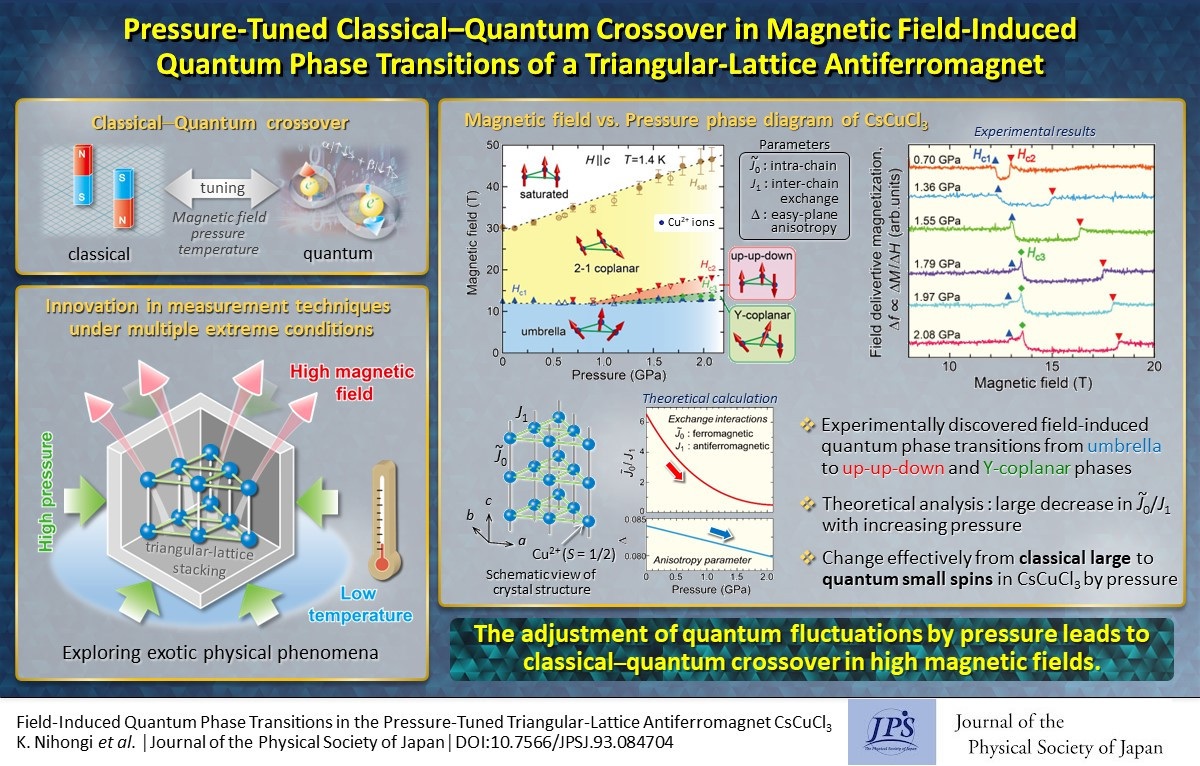Pressure-Tuned Classical–Quantum Crossover in Magnetic Field-Induced Quantum Phase Transitions of a Triangular-Lattice Antiferromagnet
© The Physical Society of Japan
This article is on
Field-Induced Quantum Phase Transitions in the Pressure-Tuned Triangular-Lattice Antiferromagnet CsCuCl3
J. Phys. Soc. Jpn. 93, 084704 (2024).
The correspondence principle states that as quantum numbers approach infinity, the nature of a system described by quantum mechanics should match that described by classical mechanics. Quantum phenomena, such as quantum superposition and quantum correlation, generally become unobservable when a system approaches this regime. Conversely, as quantum numbers decrease, classical descriptions give way to observable quantum effects. The external approach to classical–quantum crossover has attracted research interest. This study aims to demonstrate a method for achieving such control in materials.

The high-pressure application is an experimental means to significantly alter the microscopic physical parameters of a material. At ambient pressure, these physical parameters generally do not change significantly, regardless of the temperature. Recently, the effects of high pressure have been studied across a broad area of condensed matter physics, including pressure-driven high-temperature superconductivity and topological phases. Frustrated quantum magnets are expected to be significantly affected by pressure because frustration due to competing interactions gives rise to many low-energy states with small energy differences. Additionally, small quantum fluctuations play an important role in manifesting unconventional physical phenomena, such as unconventional quantum phases. Therefore, applying external pressure to frustrated quantum materials enables the manipulation of quantum correlations across the classical and quantum mechanical regimes, facilitating the exploration of exotic phenomena along the crossover.
This study explores an exciting example of a frustrated antiferromagnet—triangular-lattice compound CsCuCl3. To generate the phase diagram of magnetic field vs. pressure for this compound, we utilized our newly developed proximity detector oscillator system and high-pressure cell to measure magnetic susceptibility in pulsed magnetic fields exceeding the saturation field up to 55 T, under pressures of up to 2.08 GPa. We observed the field-induced quantum phase transitions from umbrella to up-up-down (UUD) and Y-coplanar phase immediately below the UUD phase above 0.90 and 1.7 GPa, respectively. Moreover, we calculated the pressure dependence of the transition fields, including the saturation field, and reliably determined the exchange interaction and easy-plane anisotropy parameters under pressure. With increasing pressure, the magnitude of the inter-chain antiferromagnetic exchange interaction increased linearly, whereas the magnitude of the intrachain ferromagnetic exchange interaction decreased significantly. Consequently, the ratio of the intra- to inter-chain exchange interactions decreased substantially with increasing pressure, indicating that the largely coupled ferromagnetic spins, regarded as semi-classical spins, became quantum spins. This suggests that the occurrence of the UUD and Y-coplanar phases is accompanied by a crossover from semiclassical to quantum spins in CsCuCl3.
(Written by Masayuki Hagiwara on behalf of all authors)
Field-Induced Quantum Phase Transitions in the Pressure-Tuned Triangular-Lattice Antiferromagnet CsCuCl3
J. Phys. Soc. Jpn. 93, 084704 (2024).
Share this topic
Fields
Related Articles
-
Unification of Spin Helicity in the Magnetic Skyrmion Lattice of EuNiGe3
Magnetic properties in condensed matter
2024-8-7
In the magnetic skyrmion lattice of non-centrosymmetric EuNiGe3, the original magnetic helicity, determined by the antisymmetric exchange interaction, is reversed, resulting in a unified helicity.
-
Having a Good Friend around Makes Life Better
Cross-disciplinary physics and related areas of science and technology
2024-7-29
It is true that having a good friend around makes life better, and this idea is also true in the quantum world.
-
Antiferromagnetism Induces Dissipationless Transverse Conductivity
Electronic transport in condensed matter
Magnetic properties in condensed matter
Electronic structure and electrical properties of surfaces and nanostructures
2024-7-24
An investigation using high-quality NbMnP crystals demonstrates that the anomalous Hall conductivity arising from antiferromagnetism is dissipationless, as expected from the intrinsic mechanism.
-
d2 Trimer and d3 Tetramer in a Pyrochlore Lattice
Dielectric, optical, and other properties in condensed matter
Electron states in condensed matter
2024-7-11
Based on the charge disproportionation of V3+ and V2+, the V3+(d2) trimers and V2+(d3) tetramers in the vanadium pyrochlore lattice of AlV2O4 are described by the orbitally-induced Peierls mechanism.
-
Structural Rotation and Falsely Chiral Antiferromagnetism: A New Combination Generating Ferrotoroidic State
Magnetic properties in condensed matter
Dielectric, optical, and other properties in condensed matter
2024-7-4
The ferrotoroidic state, an exotic state of matter with broken space inversion and time-reversal symmetries, was achieved by combining structural rotation and falsely chiral antiferromagnetism in PbMn2Ni6Te3O18.
